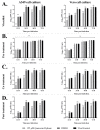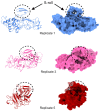Antiviral Activity of Quercetin Hydrate against Zika Virus
- PMID: 37108665
- PMCID: PMC10144977
- DOI: 10.3390/ijms24087504
Antiviral Activity of Quercetin Hydrate against Zika Virus
Abstract
Zika virus (ZIKV) has re-emerged in recent decades, leading to outbreaks of Zika fever in Africa, Asia, and Central and South America. Despite its drastic re-emergence and clinical impact, no vaccines or antiviral compounds are available to prevent or control ZIKV infection. This study evaluated the potential antiviral activity of quercetin hydrate against ZIKV infection and demonstrated that this substance inhibits virus particle production in A549 and Vero cells under different treatment conditions. In vitro antiviral activity was long-lasting (still observed 72 h post-infection), suggesting that quercetin hydrate affects multiple rounds of ZIKV replication. Molecular docking indicates that quercetin hydrate can efficiently interact with the specific allosteric binding site cavity of the NS2B-NS3 proteases and NS1-dimer. These results identify quercetin as a potential compound to combat ZIKV infection in vitro.
Keywords: Zika virus; antiviral activity; in silico analysis; inhibition; natural products.
Conflict of interest statement
The authors declare no conflict of interest.
Figures






References
-
- The History of Zika Virus. [(accessed on 1 November 2022)]. Available online: https://www.who.int/news-room/feature-stories/detail/the-history-of-zika....
-
- Pielnaa P., Al-Saadawe M., Saro A., Dama M.F., Zhou M., Huang Y., Huang J., Xia Z. Zika Virus-Spread, Epidemiology, Genome, Transmission Cycle, Clinical Manifestation, Associated Challenges, Vaccine and Antiviral Drug Development. Virology. 2020;543:34–42. doi: 10.1016/j.virol.2020.01.015. - DOI - PubMed
MeSH terms
Substances
Grants and funding
LinkOut - more resources
Full Text Sources
Medical

